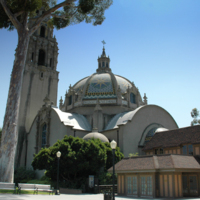
San Diego Museum of Man
The San Diego Museum of Man is an anthropological museum that originated from the 1915 Panama-California Exposition that celebrated the opening of the Panama Canal. Over the last century, the museum has expanded and developed in its original buildings at San Diego's Balboa Park. It took its present name in 1978. The museum's mission is to inspire human connections by exploring human experiences, around the world and through the ages.
The museum features twelve permanent exhibitions that explore a range of themes linking to human development and cultures. These include 'Ancient Egypt', 'Living with Animals' which explores the human practice of keeping pets, and 'PostSecret' which examines the concept of secrecy throughout societies.
Another permanent exhibition, 'Race: Are we so different?' explores the distinctions of race and the origins of racism in America. A timeline maps instances of racism throughout the nation, and includes focusses on Native American communities, as well as enslaved Africans, Civil Rights and the Jim Crow era. Text interpretation also includes biological facts about race and genetics to address long held historic views about hierarchies of race.
Initially a temporary exhibition, it was so successful with visitors the museum decided to house it permanently. 'Race: Are we so different?' was developed in conjunction with the American Anthropological Association and the Science Museum of Minnesota. The exhibition features heavily in the museum's school programmes in providing a platform to promote discussion of feeling, thinking, acting, and reflecting on race and identity, and to raise awareness and build positive relationships across communities in America today.
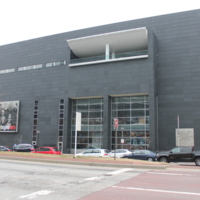
Reginald F. Lewis Museum of Maryland African American History and Culture
The Reginald F. Lewis Museum of Maryland African American History and Culture was created out of the passion and activism of businessman Reginald F. Lewis. Lewis rose from humble beginnings to earn a place at Harvard Law School, establish the first African American law firm on Wall Street and become the wealthiest African American in the US. In 1993, he died suddenly after a short illness. During his illness, he made known his desire to create a museum of African American culture and after his death, the non-profit foundation started in his memory accomplished that.
The museum is located in downtown Baltimore close to one of the several locations of former slave pens. The collection 'explores the African American experience and tells the universal story of the struggle for liberty, equality and self-determination.' The main collection is housed on the third floor and is divided into three sections: Building Maryland, Building America; The Strength of the Mind; Things Hold Lines Connect. Building Maryland, Building America has a heavy focus on slavery, explaining the roles of the enslaved in urban and rural environments. Unlike the cotton plantations of the Deep South, Maryland slavery ranged widely: tobacco plantations, shipyards, oyster shucking and iron furnaces to name a few.
Throughout the exhibitions, the interpretive text is supplemented with interactive displays, video and audio presentations and artwork. The overreaching message of the museum is that African Americans have contributed to the US since their initial forced arrival and have worked tirelessly to better their plight; through emancipation, the right to vote, the Civil Rights Movement and into the more recent social movements. The museum does not shy away from presenting the brutal side of slavery and Jim Crow, with slave collars, shackles, reward notices and video in connection to lynching are sensitively displayed.
The ground floor of the museum hosts temporary exhibitions and there is dedicated education space for the many school trips they host during the year. The museum also provides learning resources to assist with the local curriculum, offering lesson plans and outreach sessions in local schools. Throughout the year, the museum hosts a diverse range of events. The museum is open Wednesday through Sunday with a small admission fee.
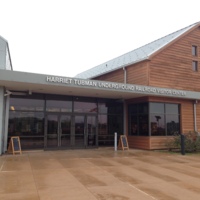
Harriet Tubman Underground Railroad National Historical Park
The Harriet Tubman Underground Railroad National Historical Park was established in 2003, the 100th anniversary of Tubman's death, in rural Dorchester County. In 2017 the Harriet Tubman Underground Railroad Visitor Centre was officially opened. The visitor centre was a collaborative project between the US National Park Service and the Maryland Park Service. The building houses exhibition space, a research library and gift shop. Also on location is a public pavilion and legacy garden.
The design of the site was built around the importance of northward movement in the slave's quest for freedom. The legacy garden stretches out north between the buildings, offering an expansive and hopeful view. The view south is more enclosed and fragmented, reflecting the intolerable existence for those enslaved. The visitor centre houses an exhibition that chronicles the life and accomplishments of Tubman; her birth into slavery, escaping and subsequently returning to free friends and family, her work as a Union spy and her activism after the Civil War. The story is told through a combination of interpretive text, videos, murals, dioramas and her own powerful words.
The park and visitor centre are open seven days a week and are free to the public. The visitor centre also provides further information on the Harriet Tubman Underground Railroad Byway Driving Tour, which has 36 stops throughout the Eastern Shore of Maryland linked to Tubman's life.
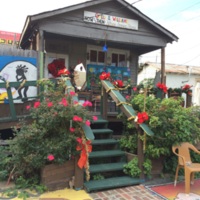
Odell S. Williams Now and Then African-American Museum
The Odell S. Williams Now and Then African-American Museum was established by Sadie Roberts-Joseph in 2001. The museum is named for Odell S. Williams, a well-loved educator in the Baton Rouge area. It was founded as Joseph identified a need in the local community for a cultural space that celebrated African American history.
The museum has a range of vibrant exhibits, showcasing the contributions of local African Americans through history, across a range of different fields. These include, music, cuisine, education, politics and business. Visitors can step onboard an authentic bus from 1953 and explore Baton Rouge's role in the civil rights movement.
The museum's display on agriculture looks at the early plantation economy of the area, and the key crops that were grown then. It also explores the experience of the enslaved Africans that who used as labour on those plantations.
It has a broad events programme, and runs the area's annual Juneteenth event.
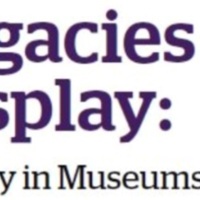
River Road African American Museum
The River Road African American Museum (RRAAM) was originally housed at Tezcuco Plantation, and opened in 1994. Due to a fire, it was relocated to its present site, a restored Caribbean-style cottage from the 1890s, in 2003. Before the museum opened, there was nowhere that charted the narrative of African American experience in the rural counties along the Mississippi. It developed its collections through donations; of buildings, objects, family documents, photographs, maps and pieces of art. The RRAAM opened with the aim of educating its visitors about the lives of Africans Americans who lived and worked on the sugar and rice plantations in the region. It has since been recognised as an international repository for African American culture in Louisiana. It hosts a varied public programme alongside its permanent displays, including touring exhibitions, concerts, lectures and school workshops.
The museum's website outlines its focus as 'more than just a slavery museum'; its key themes throughout the permanent exhibits are freedom, resilience and reconciliation. Five of the museum's displays focus on the contribution of African influence in key areas of Louisiana culture, including jazz, cuisine, medicine, art and inventions.
One key exhibit features a collection of slave inventories from local plantations- the museum lists the names of over 5,000 enslaved people. 'Free People of Colour' follows on from this as an exhibit which showcases the hundreds of people who obtained their freedom in Ascension. Outside, the RRAAM has built a 'Freedom Garden' which reveals the history of Louisiana's involvement in the Underground Railroad using a range of plants that would have been cultivated by the enslaved, both in Africa and on the plantations.
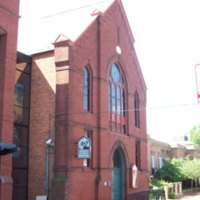
Banneker-Douglass Museum
Formerly the Mount Moriah African Methodist Episcopal Church, the site was constructed in 1875 and opened as the Banneker-Douglass Museum (BDM) in 1984. It was named after Benjamin Banneker – a free-born African American scientist and mathematician. He protested strongly against slavery, and compared the fight of the colonists to that of the enslaved people in America when writing to Thomas Jefferson in 1791. The other namesake was Frederick Douglass, a political activist, writer, and famous abolitionist who documented his experiences both escaping from and fighting against slavery. The museum is dedicated to preserving Maryland’s African American Heritage. It contains a range of both permanent and temporary exhibitions. In light of this legacy, the BDM focuses on a community-based approach to building collections and exhibitions and in providing tours, public programs, and other services. The museum's permanent exhibition is a celebration of African Americans in Maryland; providing an overview of African American history in Maryland from 1633 to the present day. Specifically the exhibition looks at Maryland’s first African American settler, Mathias De Sousa. It includes Benjamin Banneker’s almanacs, used as an anti-slavery protest to Thomas Jefferson, as well as a recording of Frederick Douglass’s speeches against racism and slavery. The museum presently partners with Anne Arundel County Public Library, offering programs and workshops at AACPL branches. It also offers guided tours of both the permanent and temporary exhibition.
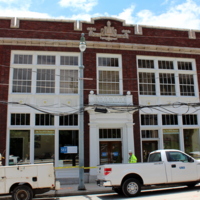
African-American Panoramic Experience Museum
The African-American Panoramic Experience (APEX) Museum aims to accurately interpret and present history from an African-American perspective in order to help all visitors understand and appreciate the contributions of African-Americans to America and the wider world. It was founded in 1978, and in 2018 curated a programme of events to celebrate its 40th anniversary.
The museum contains a range of exhibitions. These begin with a chronological display exploring the history of Africa. Another examines the experience of enslaved Africans in Georgia during the eighteenth and nineteenth centuries. Other displays bring the narrative up to date, looking at women in STEM (science, technology, engineering and mathematics), and the history of the local district Sweet Auburn, which has become a hub for African-Americans in Georgia. The museum has many artefacts including photographs, art, and traditional African material culture.
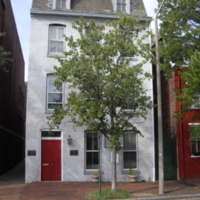
Freedom House Museum
The Freedom House Museum was once part of the headquarters for the largest domestic slave trading firm in the United States, Franklin and Armfield. Enslaved Africans were brought from the Chesapeake Bay area and forced to the slave markets in Natchez, Mississippi and New Orleans either by foot or ship. The building has a long history. In 1828, it was leased by Isaac Franklin and John Armfield and used as a "Negro Jail" or slave pen for slaves being shipped from Northern Virginia to Louisiana. During the American Civil War the museum and its surrounding sites were used firstly as a military prison for deserters, then as the L'Ouverture Hospital for black soldiers, and finally as the barrack for contraband-slaves who fled the confederate states and sought refuge with Union troops.
The building is currently owned by the Northern Virginia Urban League but the museum is managed by the office of Historic Alexandria. It operates as a reminder to the people of Alexandria of the city's role in historic slavery.
In the basement of the building there is a powerful exhibition which depicts the harsh reality of the domestic slave trade and Alexandria's role in it, through the use of first person narratives from enslaved men and women. These are complemented with a range of contextual text panels, artefacts, images and maps.
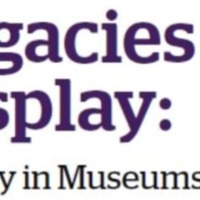
America's Black Holocaust Museum
The museum was founded in 1984 by Dr James Cameron, a self-taught historian and public speaker. The only known survivor of a lynching, Dr Cameron used his survival experience to provide visitors with a unique view of ‘living history’. Alongside this, he expanded the museum’s exhibits and employed staff, attracting local, national and international visitors. Unfortunately, the site closed following Dr Cameron’s passing in 2006 and the economic downturn of 2008. Since 2012 America’s Black Holocaust Museum has existed as a virtual museum. It seeks to educate the public of injustices suffered by people of African-American heritage, while providing visitors with an opportunity to rethink their assumptions about race and racism. It offers a range of online exhibitions, including one about the history of the museum, and another on the perpetuation of slavery through three centuries.
There are nine exhibitions available to be accessed within the virtual museum, seven of which are a chronological study of the history of Africans in America. All of them feature the museum’s four key themes: remembrance, resistance, redemption and reconciliation. Beginning with a view of life in Africa prior to enslavement, they end with an exhibition entitled ‘Now- Free at Last?’ which considers the experiences of African Americans from the 1980s up to the present day. In addition to the chronological displays, there are three special exhibitions, two of which are concerned with the victims of lynching. Within the website there are photographs, and images of objects, alongside suggestions of further reading material. There is also a section of relevant and important news articles. The virtual museum is a member of the international Coalition of Sites of Conscience, and the Association of African American Museums. The museum runs a programme of events and speakers, and is due to re-open in a physical building in Milwaukee during the Autumn of 2018.
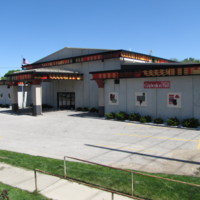
African American Museum of Iowa
The African American Museum of Iowa was founded by a small group of members of the Mt. Zion missionary Baptist church in Cedar Rapids in 1993. The museum was closed for a year during flooding, reopening in 2009. It attempts to preserve, exhibit, and teach the African American heritage of Iowa. The museum aims to examine Iowa’s African American history, from the transatlantic slave trade until Civil Rights. The museum also offers traveling exhibits available for to rent for two weeks at a small cost. It is heavily funded by donations.
The permanent exhibits at the museum are concerned with tracing Iowa’s African American history, from its origins in western Africa to the present, through slavery, the Civil War, the Underground Railroad, segregation and the Civil Rights Movement. There is also a rolling programme of temporary exhibitions on a range of themes including, art and social history. Group tours are offered for adults. These last around 45 minutes and provide additional stories, contexts, and insight into the workings of the museum throughout the tour. For younger people the museum runs field trips and hands-on workshops offering age-appropriate lessons covering local African American history and culture. There is also an online collection which includes archives, photos, library items, and oral histories.
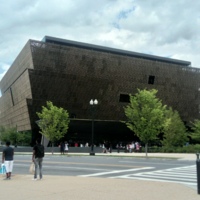
National Museum of African American History and Culture
The National Museum of African American History and Culture opened in September 2016, after more than a century of development. Designed to "tell the American story through the lens of African American history and culture," it forms the only national museum in the USA that is exclusively devoted to the documentation of African American history and culture. It stands on Washington's National Mall as the newest, nineteenth museum of the Smithsonian Institute. Established by an Act of Congress in 2003, the museum has had over one million visitors since its opening.
The displays in the museum are divided into two halves. There are three history galleries, charting key events in the history of America, with specific reference to the experience of the African American community. These galleries begin with displays about Africa prior to the slave trade, showcasing the rich culture and advanced nature of civilisations there. The displays then move on to enslavement, the Middle Passage and Plantation Life. In all of these displays, the experience of the enslaved people is central to the interpretation, and much use is made of archive material, providing quotations which bring the voices of the enslaved to the fore of the narrative.
The displays in the history galleries go on to interpret abolition, reconstruction, emancipation and Civil Rights. They end with the inauguration of Barack Obama in 2009. The displays make use of a wealth of collections, some 36,000 objects now belong to the museum. The key to the narrative throughout all of these displays is the central position of African Americans to the national history of America.
The other side of the museum consists of three 'community galleries.' Again these focus on the achievements of African Americans, through themes like sport, military, theatre, television, literature and art. Here, some of the museum's 'celebrity' artefacts, including Michael Jordan's NBA finals jersey and one of Jimi Hendrix's vests. This section of the museum also houses the 'Robert Frederick Smith Explore Your Family History Centre,’ where visitors can look at digitised archive material with expert guidance to explore their own family tree.